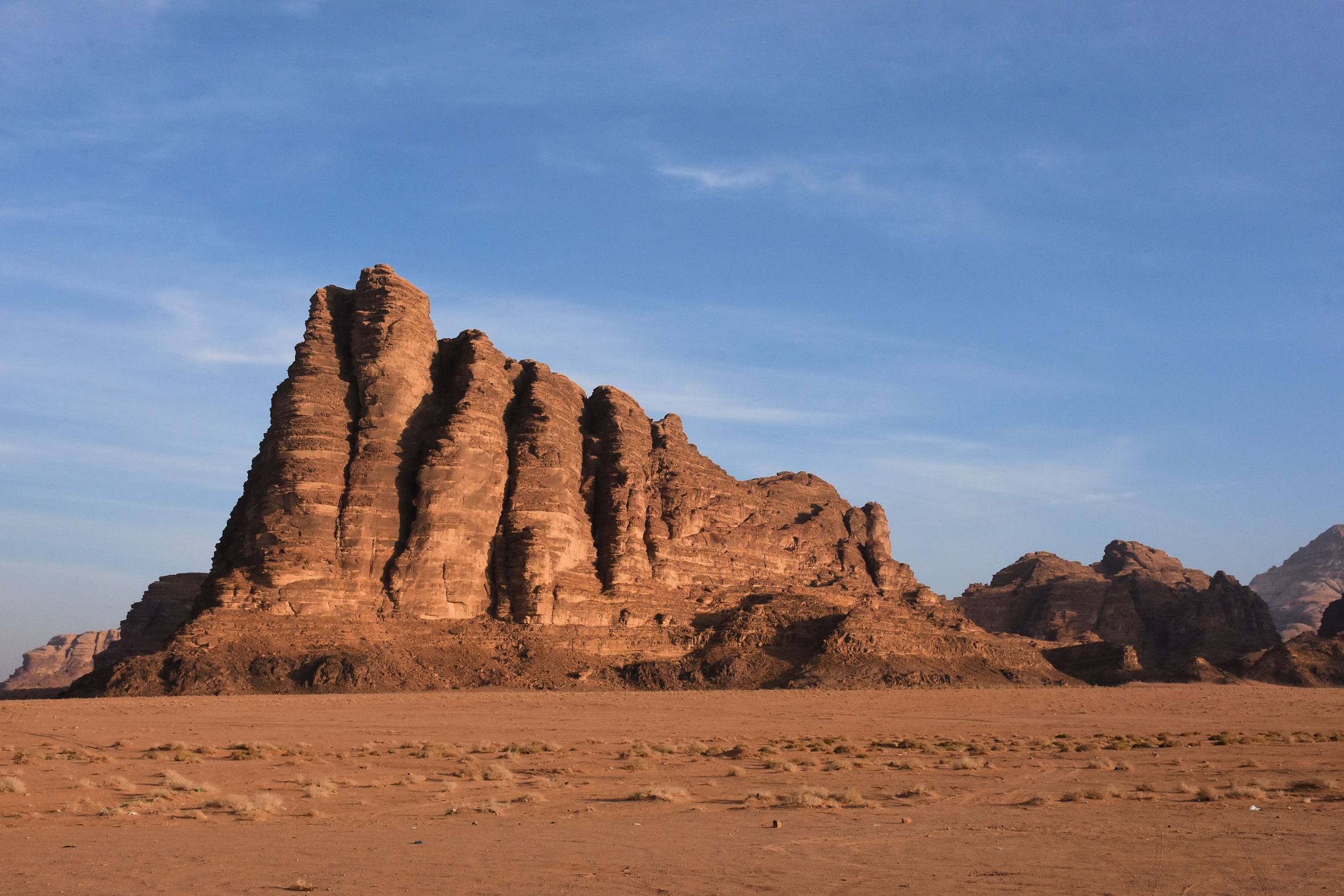
Wadi Rum, Jordan
Home to the Bedouins, this valley of the moon used to be an ocean floor. Now it is a spectacular landscape where the stars shine extra bright and tourists go rock climbing, four-wheeling, camel riding or to stay in a Bedouin camp.

Petra, Jordan
The Khazneh (Treasury) is the most prominent of all the sandstone facades in the famed city of Petra. After being ignored and forgotten for close to 2,000 years, many questions remain with respect to the time of its creation and its purpose. However, the numerous funerary images carved into the structure lead us to conclude that the building was used in association with the Nabataean Cult of the Dead.

Petra, Jordan
A glimpse of the Treasury from the Siq, a 1.2 km (0.75 mi) long gorge that served as the main entrance into the ancient city of Petra in Jordan.

Petra, Jordan
The Nabataeans, formerly nomads roaming the Arabian Peninsula, carved the city of Petra out of sandstone cliffs in the early third century B.C. Known for their hydraulic engineering expertise and amazing water management techniques, they formed channels on both sides of the Siq (gorge) to deliver water to the south-east side of Petra.

Qena, Egypt

Luxor, Egypt
Temple of Karnak.

Luxor, Egypt
Instead of cruising the Nile with passengers from all over the world, the river boats are parked and tied up due to a severe downturn in Egypt's tourism industry.

Luxor, Egypt
River boats with tourists before Egypt's economic crisis (2009)

Luxor, Egypt
Illuminated by bright lights, the Great Hypostyle Hall in the temple of Karnak in Luxor, Egypt, appears even more impressive at night than during the day time. Work on these massive columns began under the reign of the pharaoh Sety I and his son Ramses II around 1270 BC. The Hall includes 134 columns. At the height of its glory, the temple possessed 81,000 slaves, 240,000 head of life stock and 83 ships. The female pharaoh Hatshepsut contributed four obelisks to the temple, one of which can be seen in the background. The 30 m (97 ft) long obelisks were cut from pink granite in one piece and transported from Aswan in southern Egypt to Luxor by boat. Each obelisk is estimated to weigh 320 tons.

Luxor, Egypt
The statues in the avenue of sphinx at Karnak feature ram heads. The ram-headed sphinx are the symbol of the god Amon-Ra whose job it was to protect the pharaoh.

Western Thebes, Egypt
A winged solar disc in the temple of Medinet Habu. The reliefs in all temples all used to be brightly colored. Through the millennia, the paints have peeled off and only the bare sandstone remains. This motif is in a protected location and a good example of what the temples might have looked like 3,000 years ago.

Western Thebes, Egypt
The temple of Medinet Habu used to be an important economic and religious center during the Ramesside Period (20th Dynasty - 1187 - 1075 BC).

Qena, Egypt
Life in Egypt's countryside is rudimentary. Donkey carts are still the preferred method of transportation.

Luxor, Egypt
With the arrival of their new religion during Egypt's Roman period, early Christians took over many of the ancient temples and used them for the purpose of worship. The Luxor Temple alone housed 5 Christian churches. The Christians found images of the Egyptian gods offensive and did their best to chisel away at them. They also used plaster to cover up the ancient Egyptian images and painted the walls. Over time the plaster did fall off but some colourful images from the first 3 centuries A.D. remain.

Aswan, Egypt
A felucca sailing on the Nile. As the longest river on earth, the river Nile stretches for 6,853 km (4,258 mi) from it's source at the equator to the Mediterranean Sea. Eleven countries share the water from the Nile. Egypt's share is 22%.

Deir Al-Bahri, Egypt
The mortuary temple of the female pharaoh Hatshepsut at Deir Al-Bahri has a remarkable design featuring three terraces. Despite having been re-built stone by stone after its ruins were discovered in 1891, the temple will never again be as grandiose as the original one in 1450 BC. Stories about pharaoh Hatshepsut's charisma and unique leadership style has survived millennia. There are strong indications that the pharaoh was in a close relationship with Senmut, the architect of her temple.

Deir Al-Bahri, Egypt
This relief carving in the mortuary temple of the female pharaoh Hatshepsut temple at Deir Al-Bahri depicts a scene from her expedition into the "Land of Punt" (God's Land - today's Uganda). In this wall carving frankincense trees (Boswellia sacra) are loaded onto ships before being transported to Luxor and planted in the temple of Karnak. The expedition took place around 1493 BC. Over time, frankincense grew to enormous importance as it had many uses in the ancient world.

Luxor, Egypt
This colossal statue of Ramesses II is located in the Luxor Temple. Ramesses II reigned for 66 years from 1279 to 1213 BC. He is regarded by many as the most celebrated and most powerful pharaoh of the Egyptian empire. His successors referred to him as the "Great Ancestor". Ramesses II had 200 wives and concubines, 96 sons and 60 daughters. He lived to a ripe age of 91. Ancient Egypt had 170 pharaohs over 3 millennia. 7 pharaohs were female.

Western Thebes, Egypt
The two Colossi of Memnon in Thebes on the west side of the Nile represent the pharaoh Amenhotep III (1387 - 1350 BC). At a height of 18 m (59 ft) the two statues stood at the entrance of a great temple that no longer exists. Being near a busy road for over 3 millennia resulted in much vandalism and graffiti. The name "Memnon" is a term from Greek mythology.

Sherm el Sheikh, Sinai Peninsula, Egypt
Excursions to Bedouin camps in the Sinai desert are popular with tourists.

Sherm el Sheikh, Sinai Peninsula, Egypt
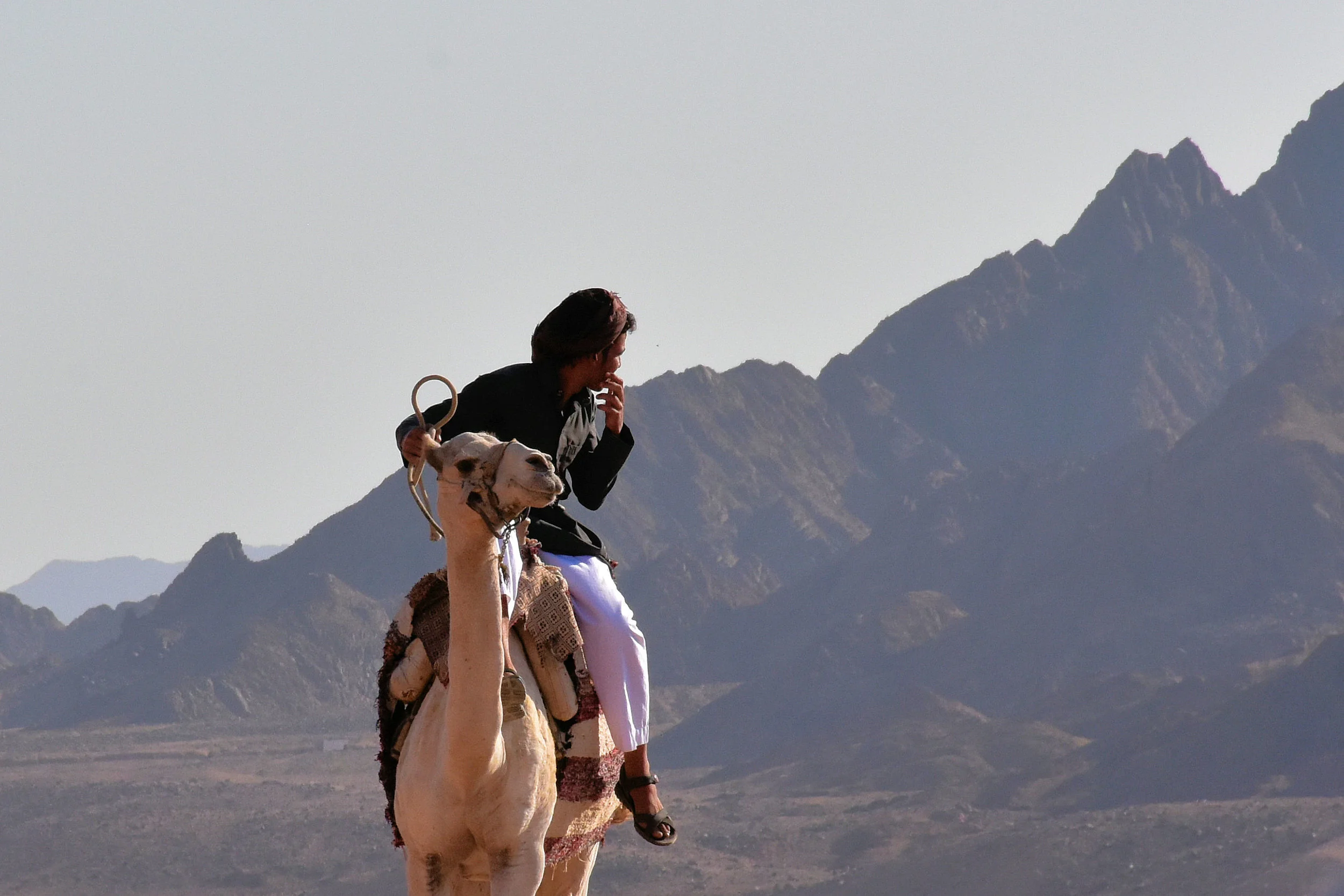
Sherm el Sheikh, Sinai Peninsula, Egypt
Bedouins in the Sinai desert depend on tourists for income. With the tourism industry in crisis, many tribes are experiencing severe hardship.

Suez Canal, Egypt

Suez Canal, Egypt
During an early November morning, the 60,000 ton vehicle carrier "Metis Leader" follows us through the Suez Canal on her way to Jeddah, Saudi Arabia and Sohar, Oman. The smooth and incident-free operation of this 193 km (120 mi) long marine highway is vital to Egypt's reputation and income. Security is tight along the entire canal with armed soldiers on duty on both sides

Suez Canal, Egypt
Shift change for Egyptian soldiers at the Suez Canal. Clearly visible is the new security wall under construction along the entire length of the canal. The cost of the wall on the east and west shore lines, will cost an estimated US $ 10 million.

Suez Canal, Egypt
The vehicle carrier Metis Leader with the Mubarak Peace Bridge in the background. The bridge was built with the help of the Japanese who contributed 60% of the construction cost. The bridge opened 2001 in the hope that it would speed up the development of the Sinai Peninsula.

Suez Canal, Egypt
The El Ferdan Railway Bridge across the Suez Canal is the longest swing bridge in the world. The latest version of the bridge was constructed in 2001.
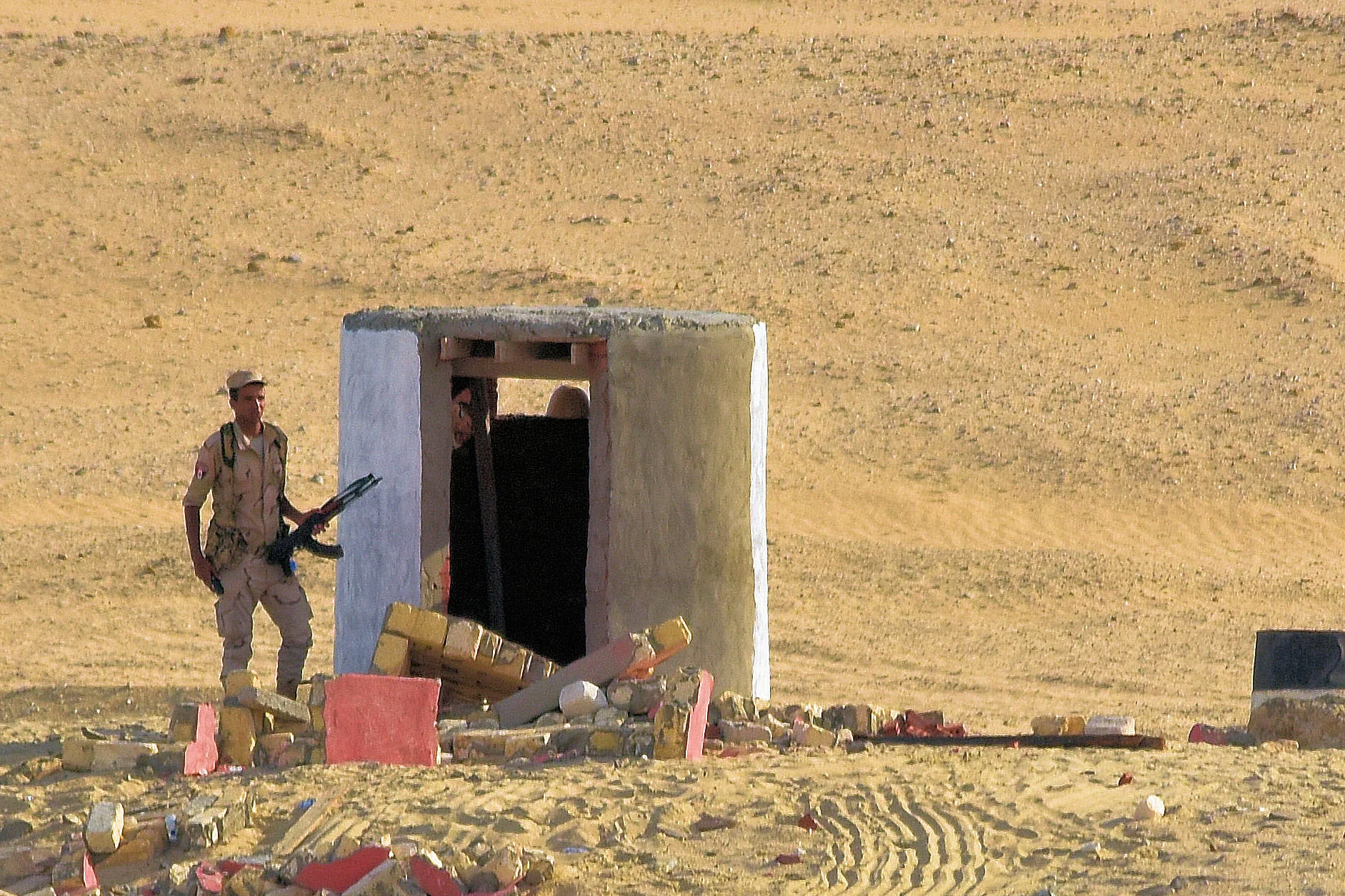
Suez Canal
With his machine gun by his side, an Egyptian soldier patrols his small portion of the canal's shoreline.

Suez Canal
Hundreds of fishermen in rowboats share the Suez Canal with some of the biggest vessels in the world.

Suez, Egypt
The city of Suez is located at the southern end of the Suez Canal and the northern end of the Red Sea. Suez has a population of approximately 610,000 inhabitants.

Haifa, Israel
The International Archives at the Baha'i World Centre in Haifa contain the sacred writings of the two prophets. Pilgrims come here from around the world to study the writings in a reverend atmosphere. The International Archives are not open to the public.

Haifa, Israel
The Shrine of The Bab at the Baha'i World Centre in Haifa, Israel.

West Bank, Palestinian Authority
Young Palestinian men hanging out at a street corner in the West Bank, Palestinian Authority.

Haifa, Israel
The Baha'i Shrine of the Bab is a mausoleum which holds the remains of The Bab, Siyyid 'Ali-Muhammad', Messenger of God and the first of two prophets. The Bab was killed by the Persian authorities in 1850 for his challenging teaching, which called for spiritual and moral renewal. The Bab was 30 years old at the time of his death. The shrine is holy to the Baha'i faith and the destination for pilgrims from all over the world.

Sea of Galilee, Israel
Pilgrims and tourists touch the water of the Sea of Galilee. Tradition believes that here, Jesus walked on water and gave his most important teachings during his three-year long ministry.

Sea of Galilee, Israel
The Sea of Galilee, where Jesus spent most of his three years of ministry, is located in north-eastern Israel near the Syrian border and the Golan Heights. The lake is 25 km long and 14 km wide. As a catchment basin for the Jordan River, it is 206 meters below sea level.
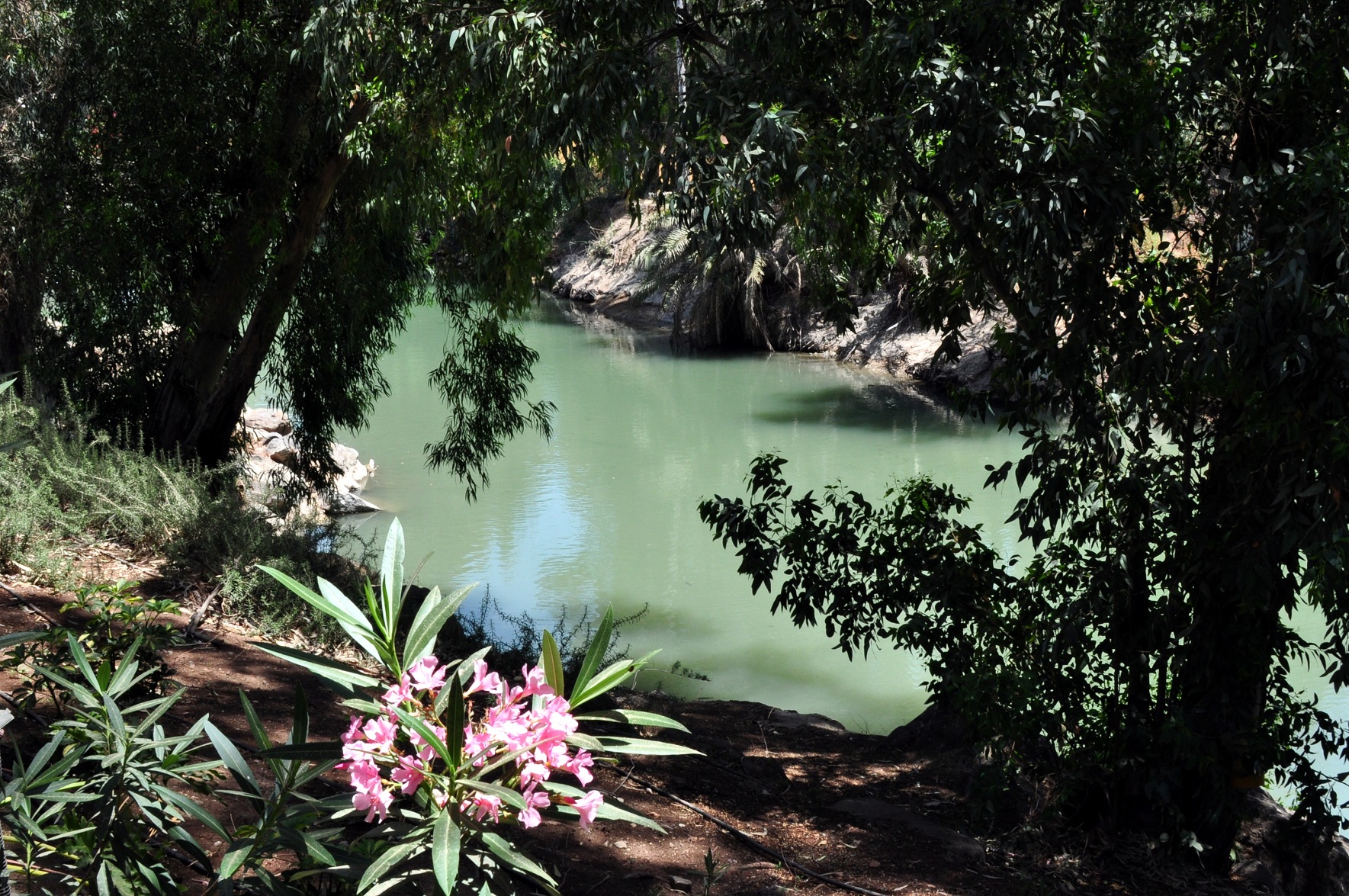
Jordan River, Israel
This is what the location, where Jesus was baptized by John the Baptist, might have looked like.

Haifa, Israel
The gardens of the Baha'i World Centre feature 19 magnificent terraces. They represent the first 19 members of the Baha'i world religion, which was founded in 1844. Now, over 170 years later, the faith has over 5 million adherents worldwide. The symmetry of the garden's design represents one of the Baha'i religion's most important tenets: equality.

Haifa, Israel
The modern face of Israel.

Haifa, Israel
The gardens at the Baha'i World Centre in Haifa, Israel.

Haifa, Israel
The view from the top of the Baha'i gardens with Haifa in the foreground, Haifa Bay and the town of Acre in the background. Further up the coast to the left is Lebanon.

Jordan River, Israel
Christians from all over the world come to the Jordan River to be baptized by immersion.

Jewish Quarter, Old City Jerusalem, Israel
The Western Wall (aka the Wailing Wall) in Jerusalem's old city is a remnant of the Jewish temple which was destroyed by Romans in 70 CE. As a symbol of national pride and victory, the wall is Judaism's most sacred location. Many faithful come here to pray and ... to get married.

Masada & the Dea Sea, Israel
The ruins of the Masada fortress are in the foreground, the shores of the Dead Sea can be seen in the background. On this plateau, a 960 strong Jewish rebel group sought refuge from the Romans. In the year 94 AD, when defeat was inevitable, all Jews committed suicide rather than being taken prisoners by the Romans. Today, Masada is a symbol of Jewish pride and resistance.

The Dead Sea, Israel
Swimming in the Dead Sea is an exercise in futility. Because of it's high salt level, the water is too buoyant. The water in the Dead Sea is 8.6 times as salty as ocean water. With 33.7% salinity, it is the world’s saltiest body of water, and the lowest spot in the world. An elevation of - 423 m (- 1,388ft) makes the Dead Sea the world’s lowest elevation on land.

Bethlehem, West Bank, Palestinian Authority
Bethlehem near the Church of the Nativity. The shepherds' fields are in the background.

Jerusalem, Israel
At the Altar of the Crucifixion, devoted Christian pilgrims in the Church of the Holy Sepulchre bend down to touch the rock where, according to tradition, the cross of Jesus once stood.

Church of the Holy Sepulchre, Old Jerusalem, Israel
The entrance to the Church of the Holy Sepulchre in the Christian Quarter of Old Jerusalem as seen from the church's court yard. The facade of the church, which contains the purported locations of Jesus' crucifixion and burial tomb, has not changed since 1854.
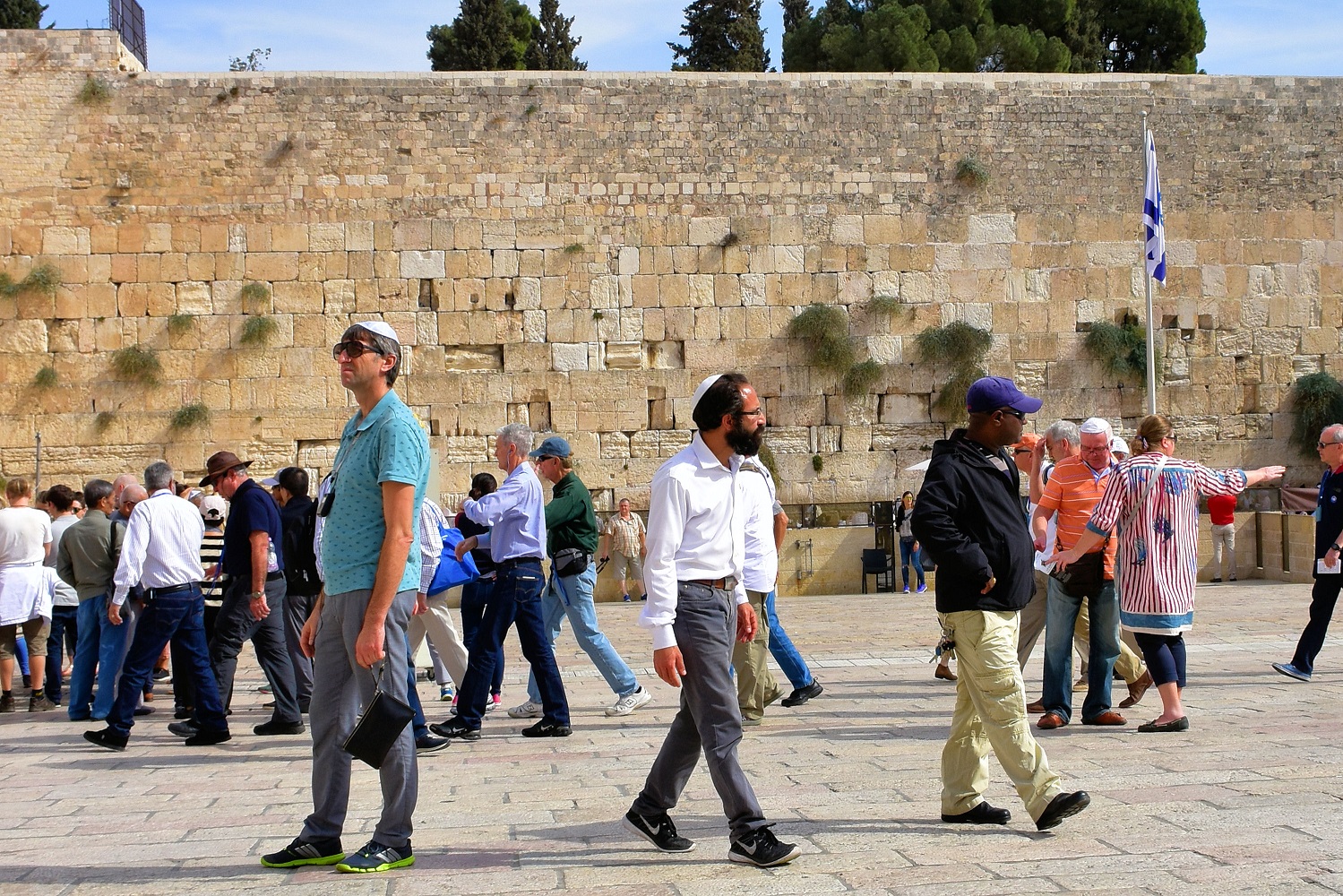
Jewish Quarter, Old Jerusalem, Israel
The Western Wall which is also called the Wailing Wall.

Old Jerusalem, Israel
The Via Dolorosa in Old Jerusalem allows pilgrims to walk the same path Jesus purportedly walked while carrying his cross to Golgotha (Calvary). Today, the road to the cross is lined with vendors and souvenir shops.

Old Jerusalem, Israel
Old Jerusalem as seen from the Mount of Olives. The Temple Mount with the Dome of the Rock is in the foreground. The two grey domes to the left belong to the Church of the Holy Sepulchre.

Mount of Olives, Jerusalem, Israel
The pictured Garden of Gethsemane is said to be the site where Jesus was betrayed and where he prayed the night before his crucifixion. Much discussion has occurred about the age of the olive trees in the garden. A recent study has shown that the 8 oldest olive trees originated from the same parent plant, an indication that someone might have tried to propagate the trees that were in the garden during Jesus' time. The three oldest olive trees are approximately 900 years old, but their roots could be much older and date back over 2,000 years.

Jerusalem, Israel
View of Old Jerusalem from the Mount of Olives. In the foreground is one of the oldest Jewish cemeteries. For centuries Jews sought to be buried here. According to the Bible, this is where the Resurrection of the Messiah will begin.
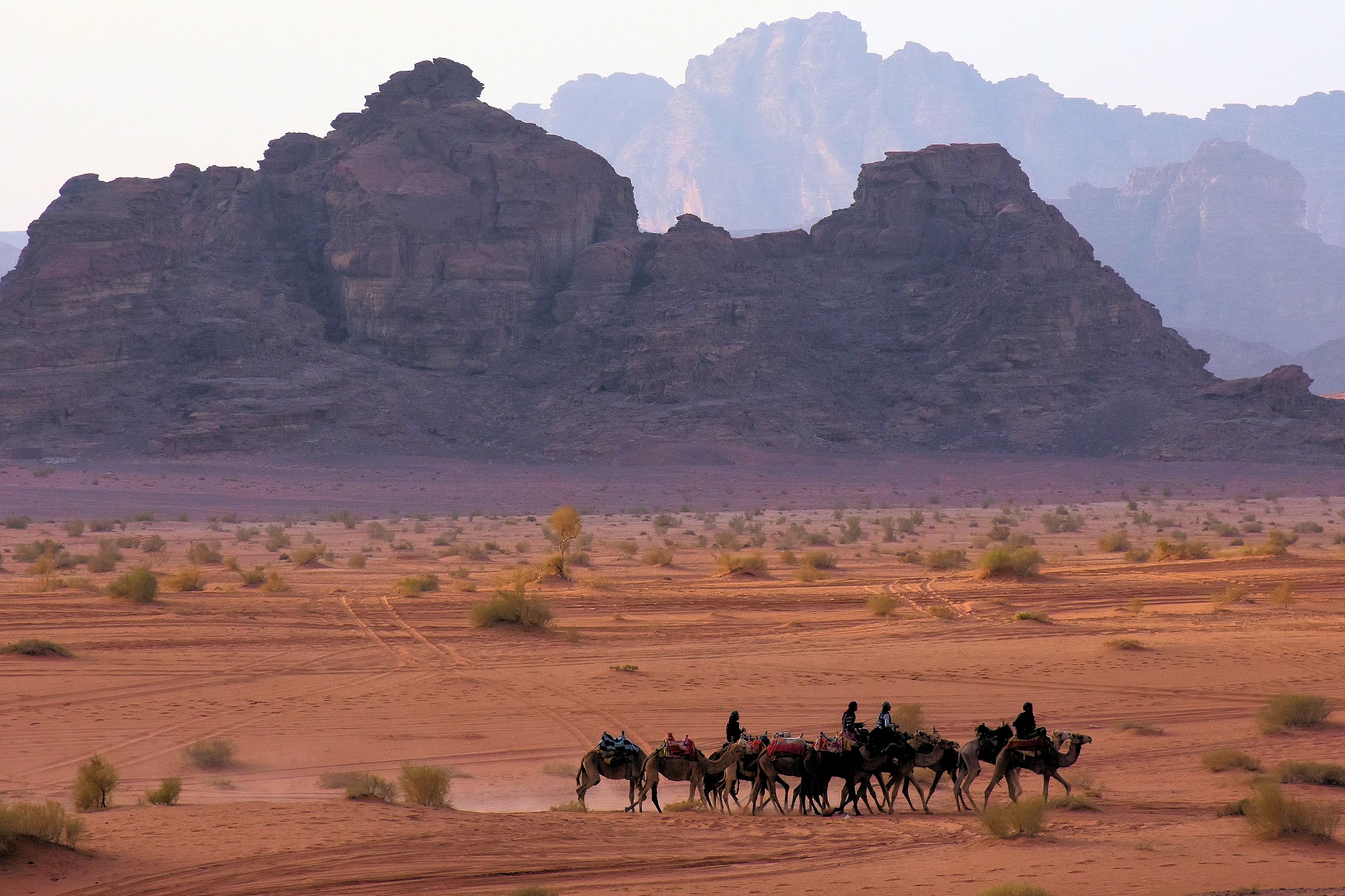
Wadi Rum, Jordan

Salalah, Oman
In Omani grave yards you can differentiate between graves for men and women. Men have two grave stone, women have three. Not much care and maintenance required in Omani graveyards.

Wadi Rum, Jordan

Wadi Rum, Jordan
A warm welcome by the local Bedouins in Wadi Rum.

Salalah, Oman
Camels are cherished by Omanis. The have the right of way on all roads. The camel on the right got a bit nervous about the traffic and tried to jump the barrier.

Wadi Rum, Jordan
Four-wheel drive excursions are very popular in Wadi Rum. Any expectations for tranquility and an awe-inspiring atmosphere should be left at home.

Salalah, Oman
The Sumhuram Archeological Park is a UNESCO World Heritage Site near Salalah, Oman. These ruins, located in the Dhofar region on the coast of the Arabian Sea, date back to the 1st century CE. It is believed that this ancient town was a busy port from where frankincense was shipped to places like Sanzibar, India and China. The town was abandoned in the 7th century CE.

Salalah, Oman
This diagram clearly shows the trade routes along which the frankincense was transported 2,000 years ago. Egypt and Petra played an important role in the trade of this aromatic.

Salalah, Oman
My guide Raya (left) explains how frankincense is harvested from a frankincense tree, Boswellia sacra (right). The frankincense tree is classified as "near threatened" by the "IUNC Red List of Threatened Species". As a desert woodland tree, Boswellia sacra is commonly tapped for it's sap in an unsustainable fashion. The trees' ability to reproduce is severely affected by the constant harvest of frankincense.
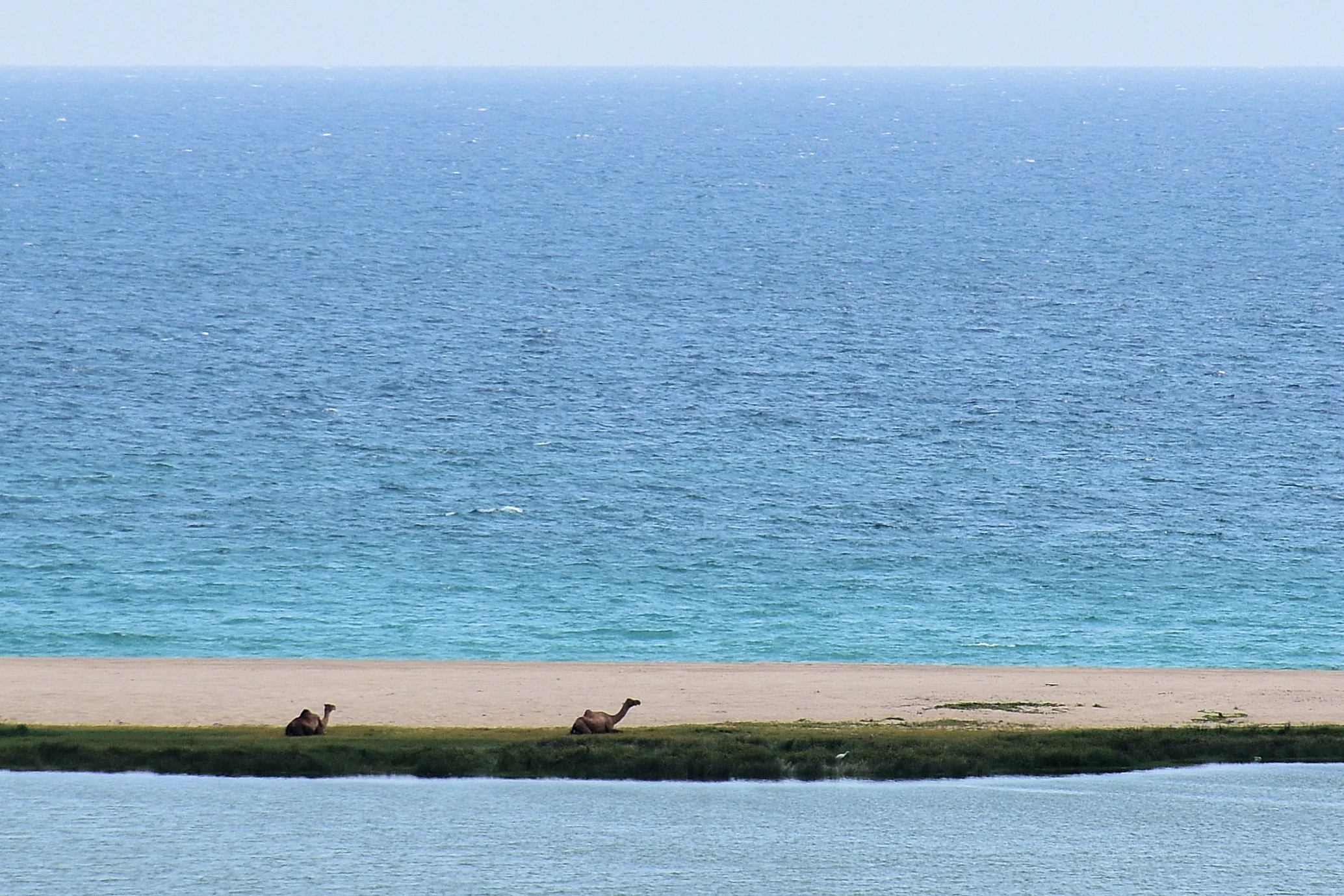
Salalah, Oman
Camels wade into the surf to take sardines right out of the ocean.

Salalah, Oman
An unusual sight: camels at the ocean.

High Tech Islam
The 210 m (689 ft) tall minaret of the Hassan II Mosque in Casablanca, Marocco, is the tallest religious structure on earth. A laser beam that reaches 30 km into the sky, is located on top. It points in the direction of Mecca and definitely is a sight to behold.

Digital Boabab
The best known "upside-down trees" live in Madagascar, but this species of the famous baobab (Adansonia digitata) is native in the savannahs of Tanzania. With branches and trunks similar to roots, the tree looks like it has been planted upside down. Amazingly, the span of the root system below the surface is greater than the height of the tree. The baobab is without leaves during the dry season. This picture was taken in November, the beginning of the wet season. Boababs can grow older than a thousand years.
Selous Game Reserve, Dar Es Salaam, Tanzania

Cairo, Egypt
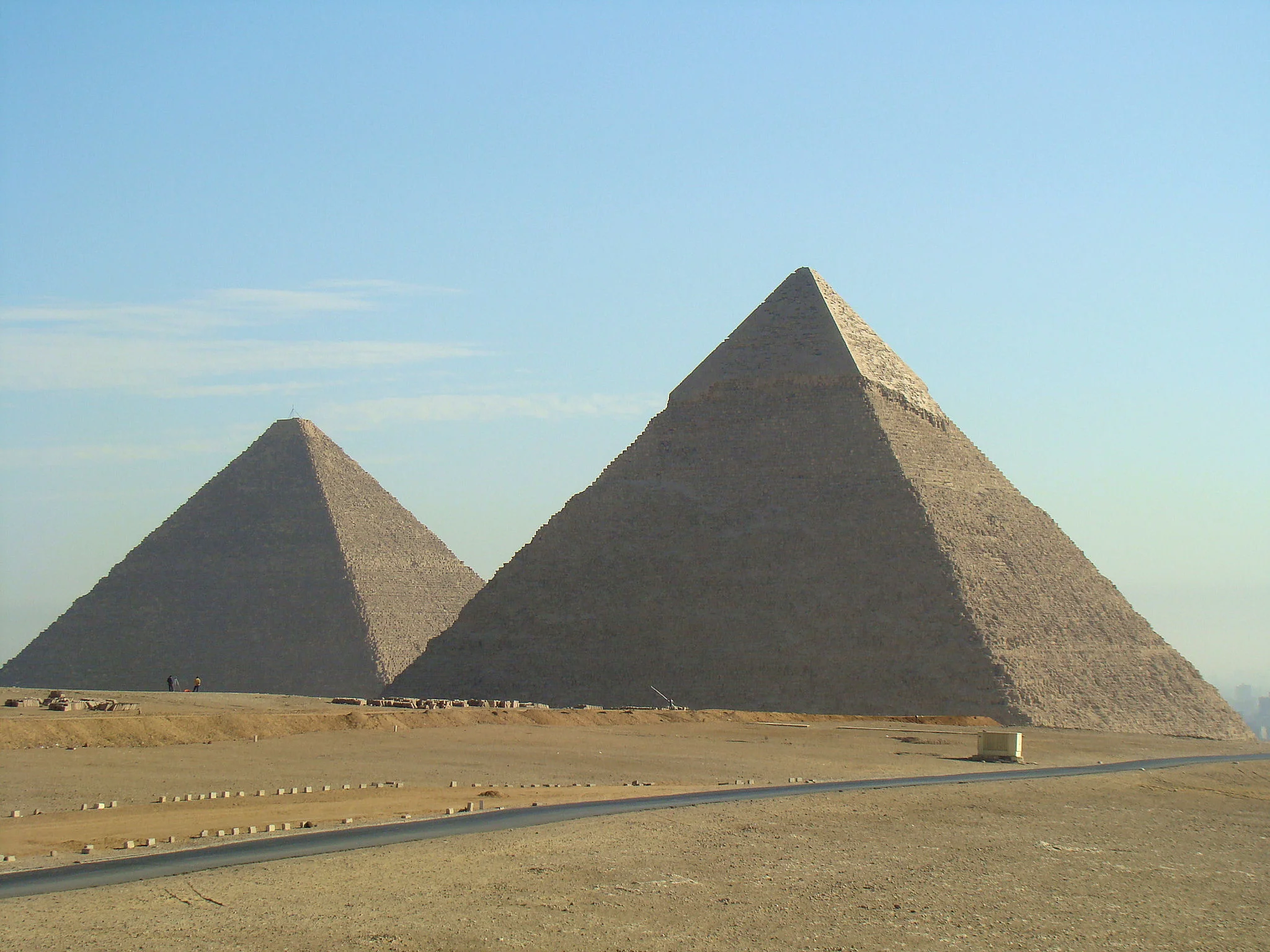
Cairo, Egypt

Cairo, Egypt




































































